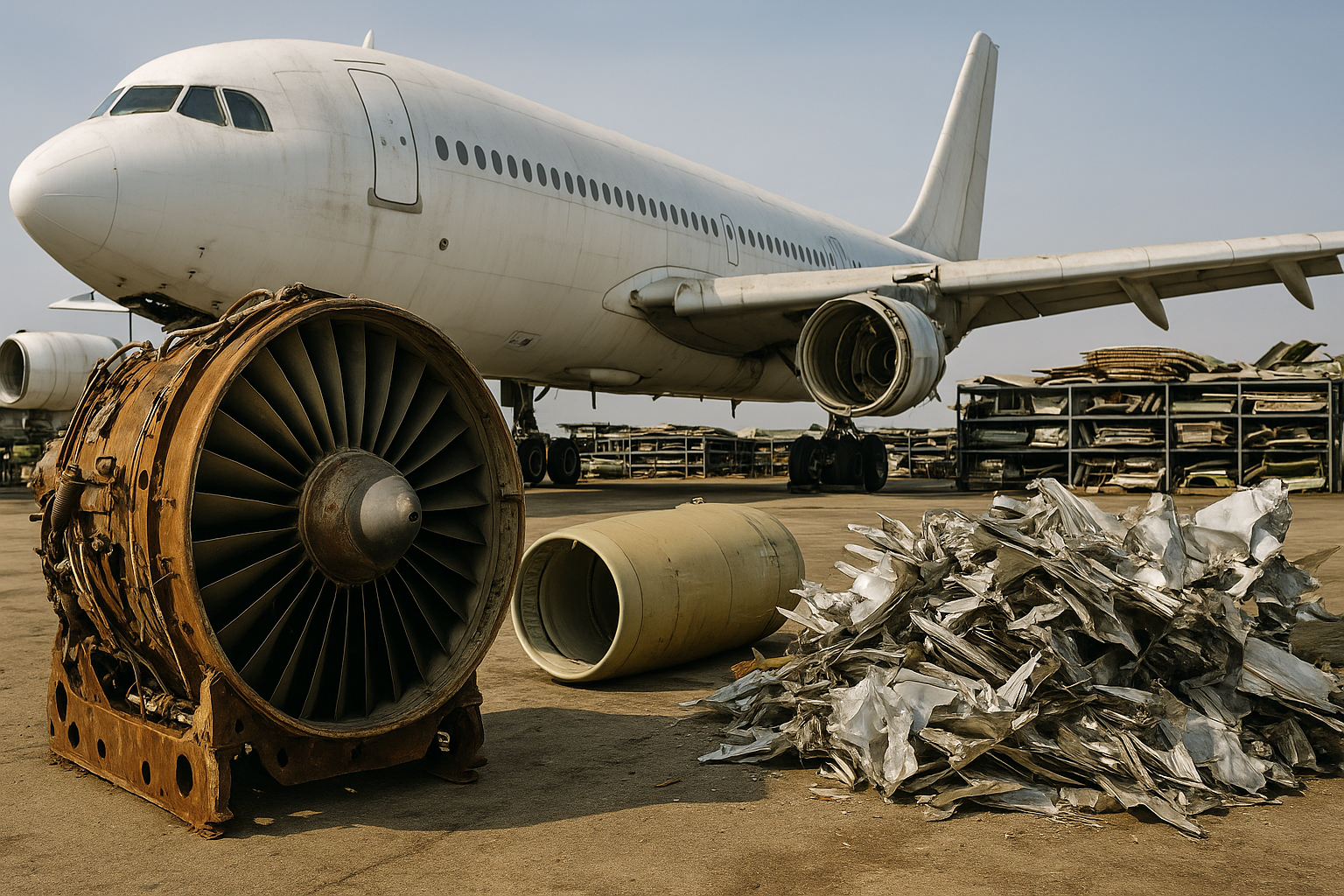
AeroGenie — Your Intelligent Copilot.
The Role of Lifecycle Data in Aircraft Parts Management
May 21, 2025
Smart fleets run on smart data. This deep dive explores how data lifecycle insights—from manufacture to end-of-life—are transforming aircraft parts management.
Modern aircraft parts management is about more than keeping parts stocked—it’s about knowing the story of every component from birth to burial. The industry has to keep a family tree and diary entries for how every critical part is used.
This exhaustive process, referred to as managing lifecycle data, covers all information captured over a part’s usable life: design specs, raw materials, manufacturing processes, operational history, maintenance cycles, and its ultimate decommissioning and disposal.
As the aviation sector faces mounting pressure to become more sustainable and data-driven, lifecycle thinking has emerged as a competitive imperative.
Organizations like the Aerospace Technology Institute (ATI) emphasize that environmental responsibility in aviation hinges on understanding and acting on the full lifecycle impact of aircraft components. This goes far beyond emissions tracking during flight; it includes the energy of materials like aluminum and CFRP (carbon fiber reinforced plastic), emissions during production, and how easily those parts can be recycled when they’re done flying (ATI).
The role of lifecycle data is also expanding under regulatory and economic pressures. ICAO, the EU Green Deal, and Flightpath 2050 goals are pushing aircraft manufacturers and operators to reduce emissions, noise, and material waste across an aircraft’s entire existence (ATI, European Commission, EU Flightpath 2050).
Lifecycle intelligence helps achieve such aims by turning every bolt, bearing, and bracket into a known quantity with a measurable footprint.
Why data lifecycle matters more than ever
Aircraft are expensive, sprawling systems with tens of thousands of parts, all under scrutiny from regulators, financiers, and passengers.
Most parts management systems are limited, focused on logistics, not lifespan. But as fleets age and environmental goals intensify, that mindset no longer cuts it.
Lifecycle data changes the game. It gives operators the ability to predict part failures before they ground a plane, model the environmental impact of replacements, and make choices based on total lifecycle cost, not just upfront price.
For example, carbon fiber parts may be more expensive to manufacture, but if they shave weight, they save fuel over the long haul. Knowing when that tradeoff tips in your favor is a data problem—and a massive opportunity (International Journal of Advanced Manufacturing Technology).
Moreover, lifecycle data is essential for sustainability audits and regulatory compliance. As the ATI notes, emissions don’t just come from engines—they start in the factory. Data lifecycle management allows airlines to trace the CO₂ and NOx footprint of each part, prove their sustainability claims, and participate in circular economy initiatives, like part reuse and recycling.
How lifecycle data drives smarter maintenance and repair decisions
Traditionally, aircraft maintenance followed rigid schedules or reactive repair protocols. But with data lifecycle management, smarter, predictive and condition-based maintenance is now possible, shifting the industry from “fix it when it breaks” to breakage prevention.
Knowing exactly how a part was manufactured, what materials it contains, the stress loads it’s been exposed to, and its repair history allows MRO (maintenance, repair, and overhaul) teams to make far more informed decisions.
For example, a composite panel made from NCF carbon fiber may show different wear patterns than one made from woven fiber, even in identical conditions. Lifecycle data provides the evidence to adjust inspection intervals, prioritize proactive replacements, and reduce unplanned downtime.
It also lets operators track the environmental cost of MRO activities. According to the ATI, MRO processes can be energy- and resource-intensive, often involving hazardous materials (ATI). By linking maintenance records with lifecycle data, operators can evaluate not just cost and performance, but the sustainability impact of repair versus replace decisions. This insight is critical for achieving circularity targets and reducing aviation’s carbon footprint.
The sustainability payoff of tracking from cradle to grave
Aircraft parts don’t just disappear when they’re decommissioned—but too often, data about their material makeup, environmental impact, and potential recyclability does. That gap has real consequences.
According to both ATI and life cycle assessment research from Cranfield University, how parts are manufactured and disposed of plays a major role in aviation’s climate burden (ATI).
Lifecycle data allows organizations to evaluate whether a part can be refurbished, reused, or recycled. CFRP components, for example, are lightweight and fuel-efficient in use but can be environmentally costly to produce and difficult to recycle. Knowing the composite type (e.g., thermoplastic vs. thermoset), the resin used, and the fabrication process (prepreg, injection molding, etc.) allows operators to select proper end-of-life pathways such as pyrolysis or mechanical recycling (International Journal of Advanced Manufacturing Technology).
Such insight moves sustainability from an abstract goal to a tactical advantage. With data in hand, parts managers can choose materials not just for strength and weight, but for total lifecycle impact, including how many emissions will be avoided if the part is recycled instead of landfilled.
How digital twins extend the value of lifecycle data
Lifecycle data isn’t static. It grows richer as aircraft parts live, fly, wear down, and undergo maintenance. Digital twins, virtual replicas of physical components, leverage this ongoing stream of data to simulate, track, and predict performance in real-time (ATI).
When paired with embedded sensors and IoT feeds, digital twins can alert operators to impending fatigue or environmental stressors before physical signs appear. As one example, an engine blade tracked through its entire lifecycle—from alloy selection to current heat exposure—can be virtually stress-tested under various flight scenarios. Such insights help technicians pinpoint early-stage failure, refine MRO scheduling, and reduce inspection time.
Moreover, digital twins offer a pathway to broader sustainability modeling. Operators integrating environmental data can run simulations for performance and carbon reduction. The ATI has highlighted this as a crucial next step in reducing lifecycle emissions across the fleet, especially as new propulsion systems and materials like hydrogen and CFRPs enter the market.
Why circular economy efforts need lifecycle traceability
The aviation sector’s shift toward a circular economy hinges on one factor: traceability. Without knowing where a part came from, what it’s made of, and how it’s been used, there’s no scalable way to recycle, remanufacture, or repurpose aircraft components responsibly.
The EU’s PAMELA project (Process for Advanced Management of End of Life of Aircraft) showed that up to 95% of aircraft materials can be recovered when dismantling is done systematically with full data visibility (European Commission).
Yet in most current systems, lifecycle records are fragmented across several suppliers, operators, and OEMs. That fragmentation makes it hard to isolate hazardous materials, identify reusable components, or match reclaimed parts with new certification standards.
Lifecycle data solves this by acting as a “digital passport” for each component. With it, teardown crews can safely disassemble aircraft, sort valuable alloys from hazardous waste, and divert usable composites into new applications.
Recovered parts can be reintroduced to the market with confidence, without compromising safety or sustainability.
The case for LCA in parts procurement and supplier strategy
Lifecycle assessment (LCA) is a strategic part of aviation procurement. Every part purchased affects fuel burn, maintenance frequency, and eventual disposal costs. LCA gives procurement teams the long view: emissions, energy use, and environmental impacts from raw material extraction to end-of-life.
A Cranfield University study, comparing aluminum and carbon fiber reinforced polymer (CFRP) wing skin panels, drives this home (International Journal of Advanced Manufacturing Technology).
While aluminum had a lower manufacturing footprint due to efficient recyclability, it became more environmentally harmful once the operational fuel burden of its higher weight was factored in. CFRPs with optimized fiber and resin combos, along with proper recycling, outperformed aluminum on lifetime CO₂ emissions, despite more energy-intensive manufacturing.
Procurement teams that incorporate LCA data into supplier decisions can avoid short-sighted trade-offs and meet the mounting pressure to prove out carbon neutrality across their entire supply chains.
Standardization and modeling tools to unify lifecycle efforts
Lifecycle data only becomes actionable when it’s standardized and modeled in a way that stakeholders across the ecosystem can interpret and use. Here, tools like the Aerospace Technology Institute’s environmental modeling frameworks come in (ATI).
The ATI is investing in whole-aircraft data lifecycle management tools to assess CO₂, NOₓ contrail formation, water vapor, noise, and recyclability. These tools allow for better side-by-side comparisons of different technologies, fleet mixes, and fuel types. They also help identify where investment in R&D will deliver the highest return in carbon abatement.
Without such standardization, it’s hard to benchmark or forecast. One OEM’s “recyclable” claim might refer to aluminum components, while another might refer to reprocessed thermoplastics. Unified frameworks and lifecycle definitions ensure everyone, from part designers to teardown crews, is speaking the same language.
And with global efforts like ICAO’s CORSIA and the EU’s Emissions Trading System tightening around aviation, having these shared tools is necessary for compliance and competitiveness (European Union Climate Action, ICAO).
Why end-of-life modeling is no longer optional
For decades, end-of-life (EoL) has been aviation’s blind spot. Retired aircraft were stored, stripped for parts, or sold off—often with little oversight. But that’s changing fast. As materials like CFRP become dominant in aircraft design, the challenge of safely, economically, and sustainably retiring aircraft has become impossible to ignore (International Journal of Advanced Manufacturing Technology).
The PAMELA project, funded by the EU, proved that up to 95% of an aircraft’s components can be reused, recycled, or recovered with proper processes, far beyond the 60% most commonly achieved (European Commission: LIFE Public Database).
The project created full-scale EoL trials and proposed new EU standards for disassembly, materials separation, and traceability. It also addressed the safety risks of unregulated secondhand parts markets and environmentally risky teardown methods.
When parts managers and OEMs incorporate EoL modeling into their decision-making, they can cut waste, reclaim valuable materials, and prevent further downstream environmental harm.
Data challenges in lifecycle tracking (and why digital twins help)
One of the biggest roadblocks to meaningful lifecycle insights is messy, incomplete, or inconsistent data. With fragmented airspace systems, manual recordkeeping in MRO, and black-box supplier networks, many aircraft components lack a full, traceable lifecycle record.
Here, digital twins are invaluable. By creating a digital representation of a physical component, including its materials, energy usage, maintenance history, and operating conditions, stakeholders gain valuable insights.
The ATI notes that digital twins are increasingly used to optimize manufacturing processes, cut scrappage, and reduce rework (ATI). But their impact doesn’t stop at the factory floor.
Digital twins can also help identify parts nearing environmental EoL thresholds, flag energy-inefficient designs, or guide decisions about repair versus replacement. At teardown, digital twins provide a clear map of what’s recyclable, recoverable, or hazardous, making recycling operations faster and safer.
Increasingly, digital twins are proving a necessary bridge between the physical and the traceable.
When lighter isn’t always greener: the CFRP paradox
Carbon fiber reinforced polymers (CFRPs) have long been aviation darlings: They’re strong, light, and offer dramatically improved fuel efficiency.
But it’s not a clear-cut win for the environment. According to a 2024 comparative life cycle assessment (LCA), CFRPs often have higher environmental impacts during the manufacturing and disposal phases compared to aluminum (International Journal of Advanced Manufacturing Technology).
Manufacturing CFRPs is energy-intensive, especially when using prepregs or PAN-based carbon fiber. Recycling thermoset CFRPs is also complex, typically requiring pyrolysis or solvolysis processes that are still evolving and far from universally implemented.
The study found that while CFRPs outperform aluminum over a plane’s life due to fuel savings, they only become a better environmental choice after about 300,000 km of flight.
This underscores a critical point for parts managers and sustainability leads: Material selection decisions must factor in the entire lifecycle, including manufacturing energy, recyclability, and emissions savings thresholds, not just operational efficiency. Better fuel economy doesn’t always mean better for the environment.
How data lifecycle modeling improves demand forecasting and inventory strategy
Lifecycle data also helps parts managers run tighter, smarter operations. With the ability to model the expected lifespan, failure points, and end-of-life curves for different materials and components, inventory forecasting shifts from reactive to predictive.
For example, ATI’s sustainability roadmap encourages the integration of through-life engineering data with demand planning systems. If an operator knows a particular batch of CFRP panels degrades faster due to UV exposure in certain latitudes, they can forecast higher replacement demand in those regions. Or if a part’s EoL emissions footprint spikes after a certain flight hour threshold, operators might choose to retire and recycle earlier, shaping future demand.
Integrating lifecycle data into MRO and supply chain systems lets teams order more strategically, reduce overstocking, and hit carbon reduction targets. This lifecycle-aware forecasting is the new edge in aviation parts strategy.
The messy middle: Managing inventory amid technology shifts
New technologies—hydrogen fuel cells, battery-electric systems, hybrid powertrains—are pushing aviation toward net zero.
But for parts managers, they introduce an awkward in-between phase where traditional kerosene-based systems still dominate, even as next-gen platforms slowly gain traction. Managing inventory through that transition is a high-stakes balancing act ().
According to the Aerospace Technology Institute (ATI), battery-powered aircraft will likely be limited to short-haul and urban air mobility applications for the foreseeable future due to energy density limitations. Hydrogen, while promising for regional routes, demands entirely different fuel storage, handling, and airframe integration.
That means the supply chain must continue to support legacy systems, hybrid configurations, and experimental platforms—all at once. Lifecycle data becomes essential here, helping forecast not just when parts will wear out, but when they’ll become obsolete.
In this messy middle, successful parts management means playing both sides, optimizing today’s stock while planning for tomorrow’s changing inventory needs.
Operational data: A bridge between lifecycle insight and real-world action
Lifecycle data is powerful, but it’s the added operational data that makes it actionable. Knowing a component’s full environmental impact is half the battle. Operators also need real-time insight into how those parts are performing in actual flight conditions and how those usage patterns are affecting sustainability targets.
Lifecycle data tells you the theoretical impact. Operational data proves or disproves it in context.
How data lifecycle management reshapes (MRO)
Maintenance, repair, and overhaul is one of the most resource-intensive phases in an aircraft part’s life. It’s also one of the most data-starved—until recently.
Historically, MRO decisions were based on routine schedules, past failures, or OEM recommendations. But as lifecycle data becomes richer and more integrated, MRO is being reinvented as a precision-driven, sustainability-focused discipline.
Lifecycle-informed MRO means using embedded sensors, predictive analytics, and performance tracking to extend part life only when it’s safe, and to replace parts before they become liabilities.
This reduces unnecessary waste while improving safety and aircraft uptime. Non-destructive inspection technologies and digital twins are already enabling this shift by revealing micro-fatigue and early signs of degradation without having to tear apart aircraft.
MRO activity is not just a cost-loss center, but a control point for emissions and material recovery.
Why lifecycle data is aviation’s most underutilized asset
For all its promise, lifecycle data is a strategic asset that aviation has barely begun to leverage. At every stage—from sourcing to end-of-life—comprehensive lifecycle visibility helps airlines, MROs, OEMs, and leasing companies make better decisions. Yet too often, data is scattered across paper records, siloed systems, and legacy platforms that weren’t built for real-time analysis or collaboration.
Many companies may find achieving full transparency burdensome, if not a near-impossible feat in a global supply chain with myriad contractors, subcontractors, and sub-subcontractors. Additionally, many practices are less than ethical, and any transparent surfacing could cause major fallout.
Compliance is costly, whether you’re measuring it in dollars or public opinion. However, this view is shortsighted and reveals a missed opportunity.
Full data about what’s produced, and where and how, enables aviation companies to make smarter, more cost-efficient decisions about what they purchase (and don’t purchase) based on contractor quality, flight performance, or the costs involved with salvaging or recycling a part after it's no longer airworthy.
Accurate lifecycle data also improves predictive maintenance, reducing overall MRO costs, and can guide purchase decisions that weigh fuel efficiency against asset resale value.
The transition to full circularity and transparency in supply chains is inevitable, and pushing back against the current of change is akin to treading water. Sustainability targets are tightening, and they are coming from basic table stakes for long-term resilience in aerospace.
A company’s ability to fully trace parts and components, from production to disposal, will be the difference between consumer confidence and compliance and fines and obsolescence.
Existing sustainability goals are already getting greener. Both the ICAO and EU are working toward tighter reporting around emissions and end-of-life outcomes, while OEMs face increasing pressure to design for recyclability.
For industry players still managing parts data with spreadsheets, legacy software stacks, and disconnected ERPs, it’s time for a mindset shift. Lifecycle data is becoming an operational compass, an ESG ledger, and a competitive advantage rolled into one.
Those who master it will meet rising demands long before competitors, and lead the industry's next era.
Ready to turn lifecycle data into real-world impact? ePlaneAI helps aviation leaders digitize, automate, and optimize every phase of the aircraft parts lifecycle—from procurement to end-of-life. Let our AI do the heavy lifting.
Aviation Maintenance Trends That May Gain Momentum in Uncertain Circumstances
Aircraft are staying in service longer, supply chains are a powder keg, and the tech is evolving overnight. Discover the maintenance trends gaining momentum and what they mean for operators trying to stay airborne and profitable.

October 2, 2025
Choosing the Right Aircraft Parts with Damage Tolerance Analysis
The future of aviation safety is all about the parts. Authentic, traceable parts bring optimal damage tolerance and performance to fleets for maximum safety and procurement efficiency.

September 30, 2025
How to Enter New Aviation Markets: The Complete Guide for Parts Suppliers
Breaking into new aviation markets? Learn how suppliers can analyze demand, manage PMA parts, and build airline trust. A complete guide for global growth.

September 25, 2025
5 Aviation Marketing Strategies You Should Use to Sell to Global Airlines
Airlines face shrinking margins and rising expectations. See how top strategies—dynamic offers, partnerships, personalization, and more—can close deals with global carriers.
